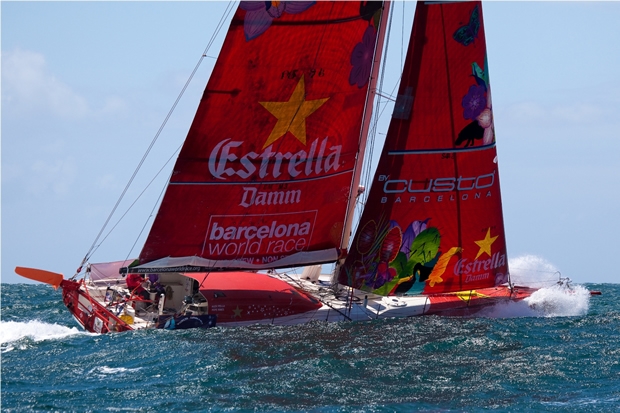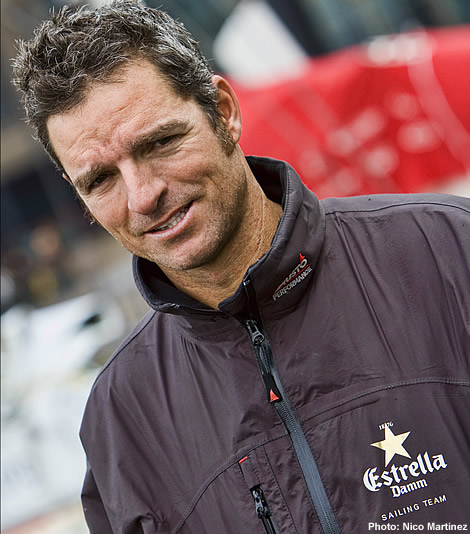
From Volvo Ocean Race to Barcelona World Race
Skippers in the Barcelona World Race come from all walks of the sailing world and along with Iker Martinez and Xabi Fernandez on Mapfre, and Andy Meiklejohn and Wouter Verbraak on Hugo Boss, Pepe Ribes is a name most associated with the Volvo Ocean Race. Long considered one of Spain’s foremost bowmen he has sailed in the fully crewed round the world race three times, first with Grant Dalton on board Amer Sports One, then on Bouwe Bekking’s ‘sinker’ movistar and ultimately with Mapfre’s Iker Martinez and Xabi Fernandez aboard Telefonica Blue. He has also competed in two America’s Cups with Bravo España and in 2007 with the Swedish Victory Challenge.
Over the last 18 months Ribes has been taking on a new challenge – learning to sail IMOCA 60s, boats that in theory are similar to Volvo Open 70s, in that they have a canting keel, but otherwise very different, weighing substantially less and with a much more ‘open’ class rule.

For this Barcelona World Race, Ribes is co-skippering the red-hulled Estrella Damm with Spanish former Mini sailor Alex Pella. Although it is a Farr design and the same generation, this boat is not the same Estrella Damm that sailed the last race with Jonathan McKee and Guillermo Altadill (that subsequently went on to become Seb Josse’s Vendee Globe steed BT and most recently Roland Jourdain’s Route du Rhum winner, Veolia Environnement). It does however have a good pedigree in the Barcelona World Race being no other than Jean-Pierre Dick and Damian Foxall’s former Virbac Paprec 2, the boat which won the first event.
Since the last race, Ribes says the boat has changed considerably. Notably they have managed to shed a huge amount of weight from her. The boat’s unique ‘turntable’ nav station/galley, has gone as has the big satcom dome inside (and as a result stacking down below is much easier). In Vendee Globe trim, Ribes reckons she weighed around 10 tonnes (much heavier than we imagined) and they have since shed around 900kg.
“The boat was very heavy,” admits Ribes. “In the Istanbul Race last year when it was quite light, we found that compared to the other boats we were very slow in the light. So one of the focuses was to make the boat more competitive in light airs.
“To have 900kg less is a lot - whenever you push through a wave or marginal surfing conditions, the weight is a big issue. So we know that we gain a little bit, but we are not 7.5-8 like the new boats. They are another generation of beast.” 7.5-8 tonnes is what the VPLP-Verdier designs are said to weigh.
They have also replaced the keel foil, in steel, rather than lighter weight carbon, as Ribes says their main aim is to complete the Barcelona World Race. They have also shed around 20kg from the mast and carried out much development work on the sails.
Even before the race started Ribes foresaw that the two new generation IMOCA 60s competing, Virbac Paprec 3 and Foncia would be the pace setters. However he didn’t expect to currently be lying in third place. He reckoned Renault ZE would be their main competition, being the sistership to their boat (formerly Loick Peyron’s Artemis Transat winning Gitana Eighty), along with Mapfre, although he couldn’t be sure as he hadn’t sailed against his old Telefonica Blue team mates since the race around Spain this summer and that was before the keel change.
Ribes was also slightly intimidated by the number of 'big names' competing in the race, many of whom such Michel Desjoyeaux, Dominique Wavre, Jean le Cam, etc have sailed 100,000s of miles in IMOCA 60s.
“You are doing tactics or strategy against a guy who is really talented and has been doing it all his life. We are newcomers. Alex has done three Minis. I have done three Volvos. I love sailing so I do everything I can do and I think I am going to love this race, but to compare us with these big names is a little bit of humility. We are not on the same page. I hope we do a good race. The next time perhaps we will be on the pace with them. That would be perfect.”
In terms of life on board, Ribes says that typically they run a three hour watch system, although this is flexible. Obviously both are on deck for sail changes and if this encroaches into their sleep time then the other stays on deck a little longer.
Sailing the boat is of course very different just two up compared to the VO70s Ribes is used to. “The most different thing is that you do the changes downwind. In the Volvo you’d never think about putting the bow down to do most of the changes [although in fact some boats were]. You do the changes doublehanded and if you bear away it is not very difficult. It is just the technique of going fast and furling fast– all the spinnakers are in socks, all the reaching spinnakers are furling, so you need to bear away, if not you can’t furl the sails on these boats, you don’t have the power to grind and furl. If you furl a sail going straight you will destroy the sail. So for me what I learn a lot from this class is taking care of your equipment – that is a key point to finishing the race. If you lose the Solent when you go around Cape Horn and you are upwind, three boats will pass you. So keeping your sails is a key point in this class.”
However sails are limited to 10 and Ribes says they aren’t carrying any spares. In addition because Estrella Damm is some 1.5 tonnes heavier than the newer competition, they are obliged to carry a big Code 0 to make up the deficit. “And we carry an A5 and A3 that are in Cuben, which is more reliable. We haven’t pushed the sails. The sailmaker will say ‘this spinnaker has to be 0.75oz’, so we do it in 0.90. We are not so concerned because our main goal is to finish the race. So we try to be safe in some areas of the sails, even if they are a little bit heavier.”
Another major difference is the water ballast. VO70s carry a modest 1200kg of water in an aft tank mounted on the centreline. In comparision, the smaller, lighter IMOCA 60s, particularly of the last generation, typically can carry up to 5 tonnes (or 50% of the displacement in Estrella Damm’s case) located in massive tanks throughout the hull.
“At the beginning it was a surprise but after using it I think it is really good! Upwind compared to a Volvo boat, on this you almost don’t slam,” enthuses Ribes. “The boat doesn’t jam the waves, it just follows the waves and you do 30% of the slamming you do in a boat with no water ballast. Downwind we know that always the back one helps a lot to make the boat easy to drive. I think it is a really cool feature of these boats.”
As one might expect, upwind in anything above moderate conditions the forward tank and the forward half of the central tank are filled and as soon as sheets are cracked, the water ballast is moved aft. Downwind the rear-most tank (or tanks if conditions are severe) are filled to get the bow out. Ribes says they never use the forward tanks in light conditions to get the fat transom out of the water, as carrying the added weight is more of a speed impediment.
“It is very interesting. At the beginning when you come into this class there are so many things you can do because it is so open, you can try whatever you want. Any idea, almost - you can do it. There are many things you want to try and test. It has been an interesting 18 months.”
Also new for Ribes was the wingmast. This he describes as a hydrid because it has one set of diamonds, but no deck spreaders. But Ribes is now sold on it. “The first time you sail on the boat you see it, it is a bit strange but then you see what the other boats have and you wonder why they don’t have this? This class has a lot of things that are really advanced in sailing.”
For Ribes personally the last 18 months have been spent not only learning the boat but also broadening his own skill set. As he puts it: “It’s been like going to university doing this. I was always specialised in boat building, hydraulics and systems. Now I am taking on electronics and computers and that wasn’t in my sight at all. We had weather training with Jean-Yves Bernot. So we have been going back to school.”
Given the rather heavy weight of Estrella Damm, Ribes reckons that their strong point should be off the breeze, ideally in stronger conditions.












Latest Comments
Add a comment - Members log in